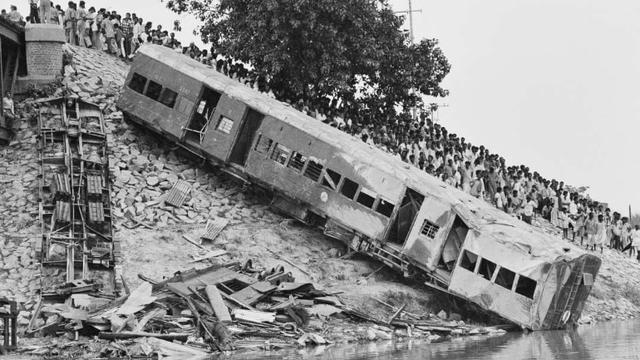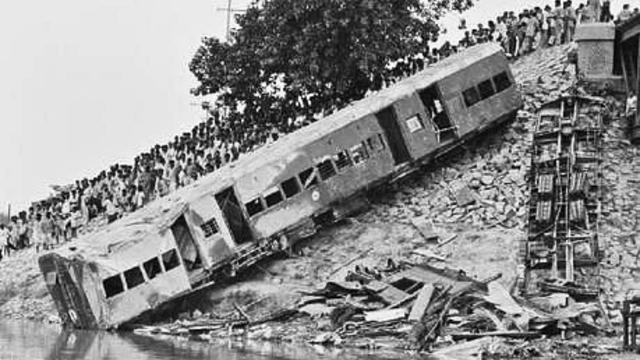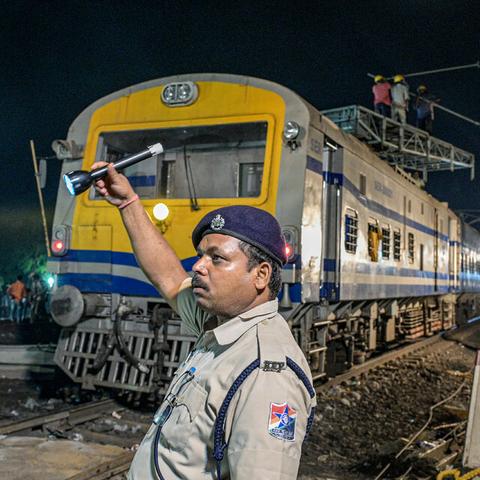Bihar Train Disaster: Tragic Accident Claims Hundreds of Lives in Northern India
“Bihar Train Accident: Tragedy Strikes as a Devastating Incident Unfolds”
We at thietbithinghiem.edu.vn believe in the importance of understanding information correctly and not immediately believing everything that circulates on social media. Therefore, in this article, we will review in depth the Bihar Train Accident, reveal its origins, analyze what happens in the video, and evaluate the facts and myths that have emerged around this video. Let’s explore further to get a clearer and more objective picture.
Main Factors that Caused the Bihar Train Accident in 1981

The Bihar train accident of 1981 was caused by a combination of factors. One of the main factors was the monsoon rains, which created slippery conditions on the tracks. The heavy rain made the tracks wet and reduced their grip, increasing the chances of a derailment. Additionally, the rain also made the Baghmati River swell, posing a greater risk to any train that might fall into it.
Another factor that contributed to the accident was the sudden braking by the train’s engineer. Reports suggested that he applied brakes sharply to avoid hitting a cow that had wandered onto the tracks. This sudden braking could have destabilized the train and led to its derailment.
Furthermore, there were also concerns about inadequate maintenance of the railway infrastructure. It is possible that poor maintenance of the tracks and bridges played a role in causing or exacerbating the accident.
Overall, a combination of monsoon rains, slippery conditions, sudden braking, and possibly poor maintenance all contributed to causing the Bihar train accident in 1981.
Factors Leading to Bihar Train Accident:
- Monsoon rains
- Slippery track conditions
- Sudden braking due to presence of cow on tracks
- Possible inadequate maintenance of railway infrastructure
Monsoon Rains and Slippery Conditions Contribute to Severity of Bihar Train Disaster
The monsoon rains played a significant role in making the conditions even more dangerous during the Bihar train disaster in 1981. The heavy rainfall not only made the tracks wet but also reduced their grip, increasing the likelihood of an accident. The wet tracks became slippery, making it more difficult for trains to maintain traction and stability.
Moreover, with torrential rains, the Baghmati River swelled, posing a greater threat to any train that might fall into it. The strong currents and rising water levels made it challenging for rescuers to reach the accident site and limited their ability to search for survivors.
The combination of slippery tracks and an overflowing river created extremely hazardous conditions for the rescue operation. It hampered the efforts of rescuers to save lives and recover bodies from the wreckage. The severity of the disaster was amplified by the adverse weather conditions caused by the monsoon rains.
Impact of Monsoon Rains on Bihar Train Disaster:
- Increased track slipperiness
- Rising water levels in Baghmati River
- Hindered rescue operations
Safety Precautions That Could Have Prevented or Mitigated the Bihar Train Accident
Several safety precautions could have prevented or mitigated the Bihar train accident of 1981. First and foremost, regular maintenance and inspection of railway infrastructure, including tracks and bridges, are crucial to detect any issues that could compromise safety. By addressing maintenance concerns promptly, potential hazards can be identified and corrected in a timely manner.
Additionally, improved signaling systems could have warned the train operator about obstructions on the tracks well in advance. This would have given them more time to react appropriately without resorting to sudden braking.
Moreover, investing in modern technologies like anti-slip systems for tracks can help improve traction even under wet conditions. These systems use materials or coatings that enhance grip, minimizing slipping risks during rainy seasons.
Furthermore, enacting stringent guidelines and regulations for train operators regarding safe braking practices can go a long way in preventing accidents caused by sudden braking maneuvers. Proper training programs should be implemented to ensure operators are well-versed in emergency response techniques without compromising passenger safety.
By implementing these safety precautions, the severity of the Bihar train accident could have been reduced, if not entirely prevented.
Safety Precautions for Prevention and Mitigation:
- Regular maintenance and inspection of railway infrastructure
- Improved signaling systems
- Use of anti-slip systems for tracks
- Strict guidelines for safe braking practices
- Training programs for emergency response
Challenges Faced by Rescuers During Search for Survivors in Baghmati River After Bihar Train Accident

The search and rescue operation in the Baghmati River after the Bihar train accident encountered numerous challenges due to the difficult conditions caused by the monsoon rains. These challenges included:
1. Strong Currents: The swollen river had strong currents that made it hazardous for rescuers to enter the water. The forceful flow of water posed a risk to their own safety, making it challenging to approach the wreckage.
2. Limited Visibility: The heavy rainfall and muddy water reduced visibility underwater, making it difficult to spot survivors or navigate effectively during rescue operations.
3. Debris and Obstacles: The fast-flowing river carried debris from the wreckage downstream, creating additional hazards for rescuers. The debris could impede progress or cause entanglements during search efforts.
4. Time Constraints: The urgency to find survivors was heightened by the fact that time was running out. With each passing moment, chances of survival diminished due to submergence underwater or injuries sustained during the accident.
Despite these challenges, rescuers persevered and worked tirelessly to locate survivors and recover bodies from the river. Their commitment and dedication were crucial in bringing closure to families affected by this tragic event.
Challenges Faced During Rescue Operation:
- Strong currents in the river
- Limited visibility due to heavy rainfall and muddy water
- Presence of debris and obstacles
- Time constraints in finding survivors
Fatalities Confirmed and Missing Passengers After Bihar Train Accident in 1981
After the Bihar train accident in 1981, at least 250 fatalities were confirmed. These fatalities were a result of passengers being trapped inside the submerged train cars or swept away by the strong currents of the Baghmati River. The exact number of missing passengers remains uncertain, as hundreds more were never found.
The severity of the disaster and the challenges faced during rescue operations made it difficult to accurately determine the total number of casualties. The fast-flowing river and adverse weather conditions hindered search efforts, potentially leaving some passengers unaccounted for.
The tragedy had a profound impact on the families and communities affected by this loss. The confirmation of fatalities brought immense grief while the uncertainty surrounding missing passengers only added to their anguish.
Fatalities and Missing Passengers:
- Confirmed fatalities: At least 250
- Potentially missing passengers: Hundreds
Improvements and Changes in Railway Safety Regulations Since Bihar Train Disaster of 1981

The Bihar train disaster of 1981 served as a wake-up call for railway authorities, leading to significant improvements and changes in railway safety regulations. Some key measures taken since then include:
1. Enhanced Track Maintenance: Railway authorities have emphasized regular inspections, maintenance, and repairs of tracks to address potential hazards promptly. This proactive approach helps ensure safer journeys for passengers.
2. Modern Signaling Systems: Advanced signaling systems have been implemented to improve communication between trains, stations, and control centers. This enables timely warnings of obstructions or dangers on the tracks, enhancing overall safety.
3. Safety Training for Railway Staff: Railway personnel are provided with comprehensive safety training to promote awareness and preparedness in handling emergencies. This includes proper braking techniques, crisis management, and adherence to safety protocols.
4. Improved Monitoring Technology: Technological advancements have been incorporated into railway operations, such as the use of sensors and monitoring devices to detect potential faults or abnormalities in real-time. This allows for immediate action to prevent accidents.
5. Emergency Preparedness: Robust emergency response plans are now in place, ensuring coordination among various stakeholders during crisis situations. Regular drills and exercises help familiarize staff with emergency procedures.
These improvements reflect a commitment to enhancing railway safety and preventing tragedies like the Bihar train accident from recurring.
Improvements in Railway Safety Regulations:
- Enhanced track maintenance
- Modern signaling systems
- Safety training for railway staff
- Improved monitoring technology
- Emergency preparedness planning
Initiatives and Campaigns to Raise Public Awareness About Railway Safety in Bihar, India

In Bihar, India, several initiatives and campaigns have been launched to raise public awareness about railway safety. These efforts aim to educate both passengers and communities living near railway tracks about the importance of adhering to safety guidelines. Some initiatives include:
1. Rail Safety Week: Railways organize dedicated weeks focused on raising awareness about rail safety through various activities such as workshops, exhibitions, interactive sessions, and distribution of informational materials.
2. Public Awareness Programs: Government agencies work together with local communities to conduct programs that educate people about safe behavior around railway tracks and platforms. These programs often involve interactive sessions led by experts who provide practical advice on safety precautions.
3. School and College Programs: Railway authorities collaborate with educational institutions to incorporate railway safety into the curriculum. Students are educated about the potential risks associated with railways and taught how to stay safe while using trains or crossing tracks.
4. Safety Campaigns at Stations: Railways install signage, posters, and videos displaying safety instructions at stations to remind passengers of critical safety measures. These campaigns aim to sensitize passengers and promote responsible behavior while using railway facilities.
5. Social Media Campaigns: Utilizing social media platforms, railway authorities launch awareness campaigns to reach a wider audience. They share safety tips, videos, and infographics emphasizing the need for caution near railway tracks.
These initiatives collectively contribute to building a culture of railway safety in Bihar by instilling knowledge and promoting responsible behavior among both passengers and communities residing near rail lines.
Railway Safety Awareness Initiatives:
- Rail Safety Week
- Public awareness programs
- School and college programs
- Safety campaigns at stations
- Social media campaigns
In conclusion, the Bihar train accident highlights the pressing need for improved railway infrastructure and safety measures in India. The devastating incident serves as a reminder of the potential risks faced by passengers and the urgency to prioritize their well-being. It is crucial for authorities to undertake comprehensive investigations, implement necessary reforms, and ensure that such tragic accidents are prevented in the future.
